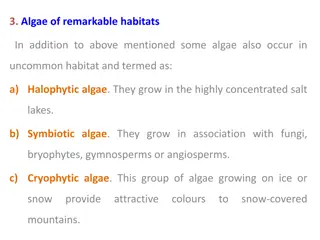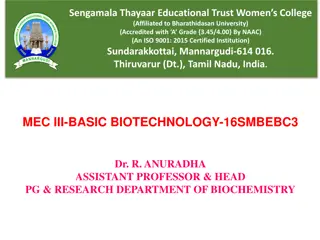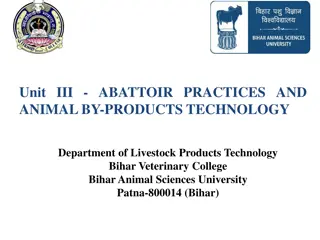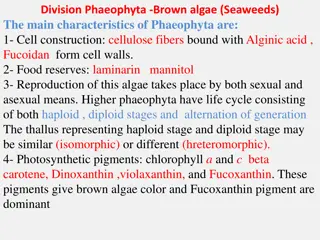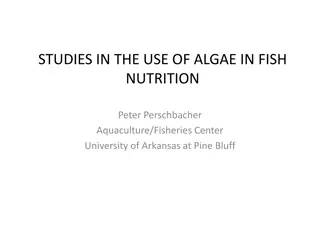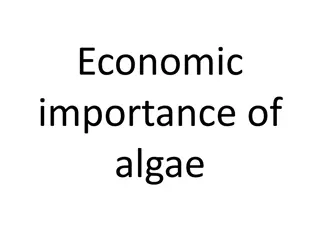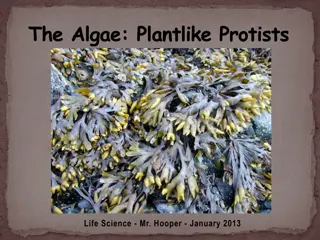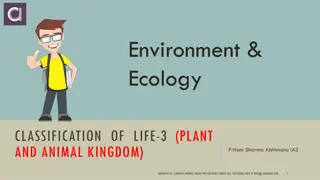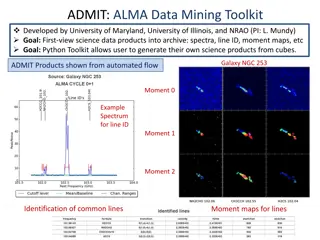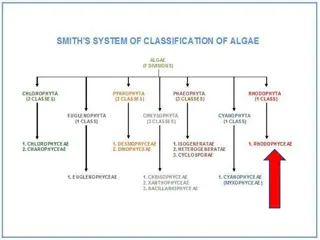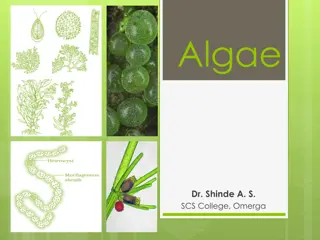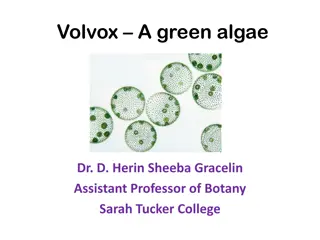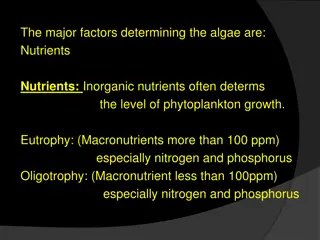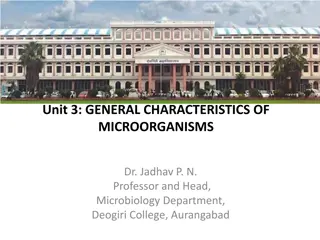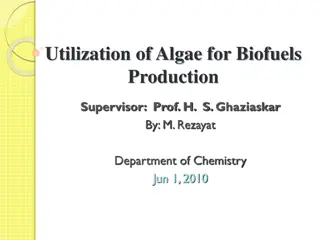Best labels for household products manufacturer in Asia, India
Winners Labels LLP. is an Indo-Korean label manufacturer headquartered in Kolkata that have been successfully manufacturing labels since inception. We have won hearts of ranges of customers across the country through our high quality products.\n\nBut we do admit that manufacturing labels for househo
2 views • 3 slides
Best CBD Company - NAM Wellness Products
NAM Wellness Products - Shop 100% organic hemp, CBD, delta 8, delta 9 products, and more. All our products are lab tested for high quality. Our products are shipped quickly with discreet shipping. Order from best cbd company now!\n\/\/ \/
10 views • 2 slides
Algae Diversity: Habitats and Classification
Algae exhibit remarkable diversity in habitats, including halophytic algae in salt lakes, symbiotic algae with various organisms, cryophytic algae on ice, thermophytes in hot springs, and more. They are classified into different groups based on pigmentation, storage products, and cellular organizati
0 views • 22 slides
Understanding Blue-Green Algae: Cultivation, Nutrient Composition, and Properties
Blue-green algae, also known as cyanobacteria, are photosynthetic bacteria that thrive in warm, nutrient-rich water bodies. They are packed with essential nutrients like vitamins, minerals, and amino acids, making them a valuable resource for overall health. Learn about the cultivation, uses, and hi
1 views • 21 slides
Understanding Gypsum Products in Dentistry
Gypsum products play a crucial role in dentistry, serving as impression materials, die materials, and models. The classification of gypsum products includes impression plaster, model plaster, dental stone, and high-strength variations. The manufacturing process varies for dental plaster and stone, w
2 views • 41 slides
Abattoir Practices and Animal By-Products in Livestock Industry
Abattoir practices and animal by-products play a vital role in the livestock industry, with more than 100 million animals slaughtered annually in India. By-products such as organs, bones, hide, and more are generated, with the potential for revenue generation. Effective utilization of these by-produ
0 views • 23 slides
Understanding Joint Products and By-Products in Manufacturing Processes
Joint products and by-products are key concepts in manufacturing processes, where joint products are of almost equal value and importance, while by-products have relatively small value but emerge incidentally. Co-products are produced simultaneously but not from the same raw material. This article e
0 views • 10 slides
United States Food Safety and Inspection Service: Ensuring Meat and Poultry Products' Safety
The United States Department of Agriculture's Food Safety and Inspection Service (FSIS) oversees the federal inspection of meat and poultry products to ensure their safety for human consumption. The statutes governing this process include the Federal Meat Inspection Act, the Poultry Products Inspect
0 views • 23 slides
Understanding Investigational Products in Clinical Trials
Investigational products play a crucial role in clinical trials, encompassing drugs, devices, biologics, and more. The FDA defines investigational new drugs as substances seeking approval, even if previously in use, with potential changes. Similarly, investigational devices are those under investiga
0 views • 43 slides
Characteristics of Phaeophyta - Brown Algae (Seaweeds)
Phaeophyta, also known as brown algae or seaweeds, exhibit unique characteristics including cellulose fibers with Alginic acid, food reserves like laminarin and mannitol, and a life cycle consisting of both haploid and diploid stages. They possess photosynthetic pigments giving them their brown colo
1 views • 26 slides
Studies in the Use of Algae in Fish Nutrition by Dr. Peter Perschbacher
Dr. Peter Perschbacher, an Associate Professor at the University of Arkansas, specializes in exploring the benefits of algae in fish nutrition. His research interests include polycultures, algae as fish meal replacements, alligator gar ecology, and more. He has received numerous honors and awards fo
0 views • 28 slides
Understanding Protists: Unicellular Organisms and Their Classification
Protists are diverse unicellular organisms that can be classified based on their nutrition and movement methods. They include protozoans, algae, and heterotrophs like molds, each playing unique roles in ecosystems. From Didinium to multicellular algae, explore the fascinating world of these microsco
0 views • 8 slides
Importance of Algae in Various Industries
Algae have significant economic importance as they serve as primary producers, food sources, fodder for animals, bio-fertilizers, and aids in soil reclamation. They play a crucial role in oxygen production, water pollution reduction, and are utilized in industries such as iodine extraction. Algae ar
0 views • 51 slides
The Fascinating World of Algae and Protists
Algae, diatoms, dinoflagellates, euglenoids, and red algae are diverse plant-like protists crucial for Earth's ecosystems. They range from unicellular to multicellular forms, contributing significantly to oxygen production and food chains. While some like red algae thrive in deep ocean waters, other
0 views • 20 slides
Understanding Algae: Classification, Habitat, and Reproduction
Algae are chlorophyllous thallophytes that thrive in aquatic environments, producing their own food and oxygen through photosynthesis. They are categorized based on habitat as aquatic, terrestrial, aerophytes, cryophytes, and thermophytes. The three main classifications of algae are Chlorophyceae (g
0 views • 16 slides
Classification of Algae, Economic, and Ecological Significance, Bryophytes Overview
Algae, classified into green, brown, and red types, play crucial roles in food, industry, and ecology. Green algae are significant in symbiotic relationships, while red and brown algae provide commercial products. Algae are vital producers in aquatic ecosystems, contributing to ecological balance. B
0 views • 18 slides
Automated Data Mining Toolkit for ALMA Science Products
The ADMIT (ALMA Data Mining Toolkit) developed by the University of Maryland, University of Illinois, and NRAO enables the generation of science products from data cubes. It supports first-view data products like spectra, line identification, and moment maps, facilitating analysis for galaxies like
0 views • 5 slides
Innovative Algae Pond Project Collaboration in Kansas
Collaborating with multiple organizations including KDHE, KSU Vet Diagnostic Lab, and KSRE Water Quality Specialists, a project in Kansas is utilizing barley straw to address blue-green algae in ponds. The project involves dosing ponds with barley straw at specific rates and locations, along with re
0 views • 11 slides
Algae: Oceans' Unsung Heroes
Algae play a critical role in our planet's ecosystem, outnumbering plants on land. The oceans are teeming with microscopic algae and seaweeds, essential for marine life. Without algae, our oceans would be barren, highlighting their crucial ecological importance.
0 views • 45 slides
Main Characteristics of Rhodophyta: The Red Algae Division
Rhodophyta, or red algae, are mostly marine algae with distinct photosynthetic pigments giving them a red color. Their main characteristics include the presence of phycoerythrin pigment, floridean starch as food reserve, thalloid plant body structure, oogamous sexual reproduction, and cell walls con
0 views • 27 slides
Global Algae
Algae by Type (Macroalgae\/Seaweed {Red, Brown}, Microalgae {Spirulina, Chlorella, D. Salina}), Distribution Channel (B2B, B2C), Form (Dry, Liquid), Application
0 views • 5 slides
Global Algae
Algae by Type (Macroalgae\/Seaweed {Red, Brown}, Microalgae {Spirulina, Chlorella, D. Salina}), Distribution Channel (B2B, B2C), Form (Dry, Liquid), Application
0 views • 5 slides
Global Algae
Algae by Type (Macroalgae\/Seaweed {Red, Brown}, Microalgae {Spirulina, Chlorella, D. Salina}), Distribution Channel (B2B, B2C), Form (Dry, Liquid), Application
0 views • 5 slides
Global Algae
Algae by Type (Macroalgae\/Seaweed {Red, Brown}, Microalgae {Spirulina, Chlorella, D. Salina}), Distribution Channel (B2B, B2C), Form (Dry, Liquid), Application
0 views • 5 slides
Fascinating Insights into Lichens: Algae, Fungi, and Ecological Succession
In the world of lichens, a unique symbiotic relationship between algae and fungi thrives, showcasing the wonders of mutualism. Through photosynthesis, algae produce glucose and oxygen, while fungi provide stability and protection on rocks. This partnership plays a crucial role in primary succession,
0 views • 4 slides
Factors Affecting Algal Ecology: Light Intensity Impacts on Algae Growth and Composition
Light intensity plays a crucial role in the growth and composition of algae. Algae undergo photoadaptation processes to adjust to varying light levels, affecting their photosynthetic efficiency and cellular properties. High light intensity can lead to photoinhibition and changes in cellular composit
0 views • 19 slides
Exploring Various Topics: Cats, Algae, Modals, and More
Dive into a range of subjects from describing cats and algae to understanding modals and defining everyday objects like clocks and whiteboards. Explore concepts such as qualifiers, conditions, and language patterns through practical examples and images.
1 views • 41 slides
Understanding Algal Culture Media for Lab Growth
Algae in natural habitats acquire essential nutrients from water, but for lab cultivation, specialized growth media are necessary. Various types of algal culture media exist, each with specific nutrient components like nitrogen, phosphorus, vitamins, and trace metals. Common media include marine alg
0 views • 6 slides
Understanding Algae: General Characteristics, Occurrence, and Classification
Algae, studied in algology or phycology, are autotrophic organisms with chlorophyll, primarily found in aquatic environments. They exhibit a variety of structures, pigments, and reproduction methods. Algae are classified into 11 classes based on criteria such as pigmentation, reserve food, and thall
0 views • 27 slides
Fascinating World of Volvox: A Green Algae Perspective
Delve into the intricate details of Volvox, a remarkable green algae, through images showcasing colony morphology, single-cell structure, asexual and sexual reproduction, as well as its life cycle. Explore the captivating world of Volvox led by Assistant Professor Dr. D. Herin at Sheeba Gracelin at
0 views • 7 slides
Exploring the Fascinating World of Algae: A Visual Journey Through Different Phyla
Dive into the diverse and intriguing realm of algae with this visual guide. From the catchall kingdom Protista to the distinct phyla Chlorophyta, Phaeophyta, Rhodophyta, Bacillariophyta, Dinoflagellata, and more, learn about their characteristics, structures, and importance. Discover how green algae
0 views • 32 slides
Factors Influencing Algae Growth in Water Ecosystems
Nutrients play a crucial role in algae growth, with inorganic nutrients like nitrogen and phosphorus being key factors. Algae require macroelements such as carbon, hydrogen, oxygen, sulfur, potassium, calcium, phosphorus, and nitrogen in large quantities, as well as microelements like iron, manganes
0 views • 16 slides
The Future of Algae Fuel: A Promising Solution for America's Energy Needs
Algae biofuel technology is essential for improving fuel sources in America. Algae's high lipid content makes it a pure source of biodiesel, with bio-engineered strains now containing up to 80% lipid. Algae fuel production, while promising, is a tedious and expensive process. Despite the challenges,
0 views • 8 slides
Exploring the Fascinating World of Algae: Characteristics, Types, and Applications
Delve into the intriguing realm of algae, from their general characteristics to the various types such as Diatoms, Green Algae, Blue-Green Algae, Yellow-Green Algae, and Red Algae. Algae range from microscopic to seaweed, serving as autotrophic organisms with reproductive structures like gametangia.
0 views • 16 slides
Utilization of Algae for Biofuels Production: A Comprehensive Overview
Algae, both microalgae and macroalgae, hold immense potential as sources of biofuels due to their high productivity and adaptability. Microalgae, in particular, are highlighted for their rapid growth rates and efficient photosynthesis, making them ideal for mass production with minimal land and wate
0 views • 31 slides
Exploring Algae: Biodiversity, Importance, and Habitats
Delve into the world of algae with Professor Olubukunola O. Oyesiku as he discusses the classification, economic importance, natural habitats, and ecological contributions of algae. Learn about the unique features that distinguish algae from other plants and explore their fossil record dating back 1
0 views • 54 slides
FDSN Working Group III Coordination of Products & Services Meeting Summary
The FDSN Working Group III Coordination of Products & Services meeting held in Melbourne on July 3, 2011, discussed the approval of 2009 minutes, revising the WG III charge, evaluating needed services for FDSN, and reviewing existing efforts from various organizations like ORFEUS, EMSC, ETH, Austral
0 views • 30 slides
WEND-100 Implementation Guidelines Report to IRCC14 Denpasar, Bali, Indonesia + VTC (Hybrid Meeting)
IHO Resolution 1/2021 introduces the WEND-100 principles, with complementary guidelines detailing their implementation for S-1XX products. The report discusses the applicability of WEND-100 principles for S-100 based products, focusing on specific S-1XX products planned for release before S-101. It
0 views • 12 slides



